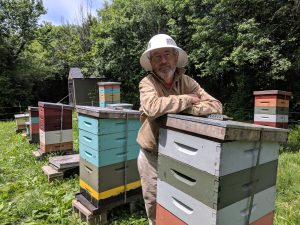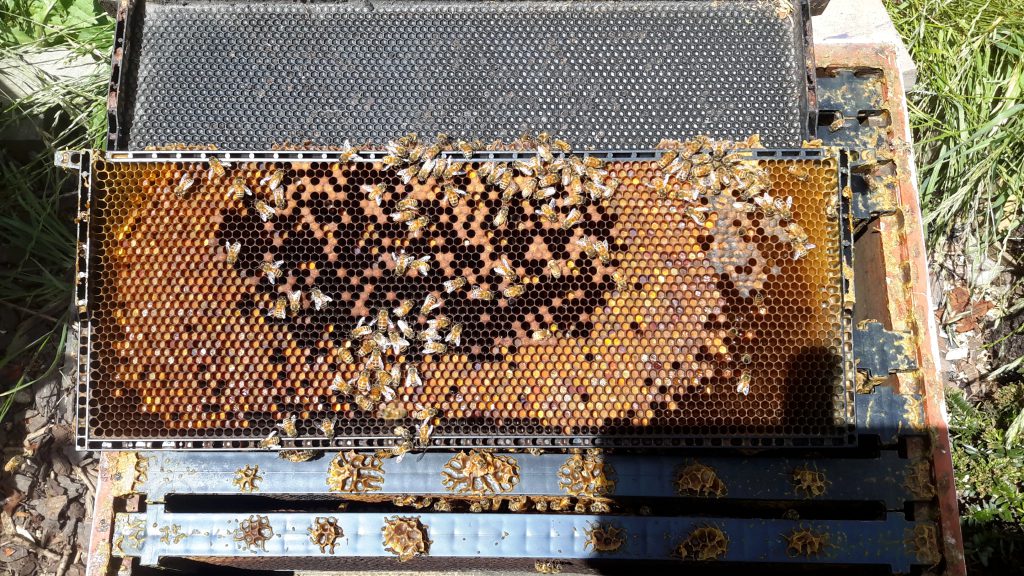Click Here if you listened. We’re trying to gauge interest so only one question is required; however, there is a spot for feedback!
Read along below!

The Plastic Legacy
Are the toxic chemicals in plastic affecting you and your bees?
By: Ross Conrad
Plastic has become ubiquitous in our lives and is clearly responsible for significant advances in fields as varied as medicine, sports, aeronautics, electronics, food packaging, textiles and construction. Agriculture has also come to rely heavily on plastic, and as beekeepers, we have come to depend on plastic for a multitude of beekeeping uses large and small. This includes every part of the hive in addition to queen excluders, smoker bellows, honey packaging, mating nuc boxes, feeders, support pins, hive wrapping and netting, propolis and small hive beetle traps, hive straps, bee helmets and brushes, extracting equipment and more.
Unfortunately, this incredibly useful stuff is also responsible for slowly and quietly inflicting widespread damage that seriously threatens human and environmental health, as well as the economy. This is well documented in a recent report by the Minderoo-Monaco Commission, and the harm includes illness and death resulting from every phase of plastic’s life cycle, and the damage is getting worse (Landrigan et al., 2023).
The report’s lead author, Dr. Phillip J. Landrigan is the director of the Global Public Health Program and Global Observatory on Planetary Health at Boston College. Landrigran, who has spent decades researching the health effects of environmental pollutants, also worked on the first studies that looked into the dangers of lead exposure in children.

During the past couple decades, plastic hive parts and beekeeping equipment have become common and yet we know little about the impacts to bees that the chemicals that leach out of plastic can have on honey bee health.
Production
As the Minderoo-Monaco Commission report outlines, plastic is made from carbon-based polymers that combine many small molecules bonded into a chain or network. Polymers can be natural or synthetic. Natural polymers include rubber, hemp and silk. While synthetic plastics can be manufactured from plant materials, most synthetic polymers are made from fossil fuels and they include polyethylene, polypropylene, polystyrene (Styrofoam), polyvinyl chloride (PVC), and a host of other materials of which over 400 million tons are produced annually and the amount is growing. Single-use plastics account for 35-40% of current plastic production and represent the most rapidly growing segment of the plastic industry.
Various chemicals are then incorporated into these carbon-based polymers to impart certain properties to the plastic being manufactured. Among the properties chemicals impart to plastic are color, flexibility, stability, water repellency, sterility, fire resistance and ultraviolet resistance. Unfortunately, many of these added chemicals are extremely toxic. They include cancer-causing compounds, neurotoxins that disrupt the cells that make up nervous systems, endocrine disruptors such as phthalates that play havoc with the body’s hormones, bisphenols, per- and poly-fluoroalkyl substances (aka PFAS or forever chemicals), as well as brominated and organophosphate flame-retardants. These highly toxic chemicals are integral components of plastic. During production, these chemicals, along with plastic particles, leak into the air, water and soil polluting the landscape and sickening those that get exposed. Many of these chemicals are responsible for the majority of plastics’ harm to human and environment health.
Use
Due to their wide proliferation throughout society, plastic is present in almost everything we use in our daily lives. Consumers are exposed to toxic chemicals as they leach out of plastic; enter the environment, and cause pollution as a result of their normal use. Sometimes exposure occurs from direct contact with the plastic item, and other times it occurs through contact with a substance such as water or food that has been in contact with the plastic. Accidental and unintended exposures also occur such as when an infant sucks on a plastic toy.
Disposal
We have known for a long time that plastic itself does not decompose, and now we learn that some of the toxic compounds used in plastic (such as the PFAS family of chemicals) also fail to biodegrade which means they do not go away (hence the ‘forever chemical’ moniker). As a result, plastics are clogging our landfills, choking our oceans, and fouling our beaches. Additionally, some plastic chemicals undergo chemical transformation and form breakdown products and metabolites, that can be highly toxic and contribute further to the harm plastics create.
Unfortunately, our current patterns of plastic production, use and disposal occur with little attention to sustainable design or safe materials and a near absence of recovery, reuse and recycling. Plastic recycling systems are so inefficient and ineffective that studies have found that less than 10 percent of the plastic humans produce and use actually gets recycled and reused while the other 90 percent gets incinerated, or ends up in a landfill or the environment. Despite rising consumer awareness, government regulation and corporate attention, we are creating more single use plastic waste than ever before. Between 2019 and 2021 the world produced an additional six million metric tons of single use plastic waste, mostly from fossil fuels. The more plastic waste we create the greater the harm to human health, widespread environmental damage, significant economic costs and deep societal injustices.
In-depth research of advanced recycling of plastic (also called chemical recycling, molecular recycling or chemical conversion) in the United States finds this new technology is a lot of hype and not much reality (Denney et al., 2022; Singla & Wardle, 2022). These so-called advanced recycling facilities are themselves generating hazardous waste and causing environmental injustices under the false promise of recycling. Even worse, since the plastic we do manage to produce from “advanced recycling” is much more expensive than virgin plastic, much of the recycling output will likely end up as fuel for incinerators creating even more pollution.
Key report findings
The report points out that while manufacture and use of essential plastics should continue, the reckless increases in plastic production, and especially increases in the manufacture of an ever-increasing array of unnecessary single-use plastic products, needs to be curbed and their use greatly reduced. We also need to eliminate the migration of plastic into the biosphere across its life-cycle by embracing environmentally sound waste management.
Among the Minderoo-Monaco Commission’s findings are:
- Plastic causes disease, impairment and premature mortality at every stage of its life cycle, with the health repercussions disproportionately affecting vulnerable, low-income and minority communities, particularly children.
- Toxic chemicals added to plastic and routinely detected in people are known to increase the risk of miscarriage, obesity, cardiovascular disease and cancers.
- Plastic waste is ubiquitous and our oceans, on which people depend for oxygen, food and livelihoods, are “suffering beyond measure, with micro- and nano-plastics particles contaminating the water and the sea floor and entering the marine food chain.”
The Commission’s science-based recommendations include a global cap on plastic production instituted through a Global Plastics Treaty.
Plastic’s impact on our industry
So, what does the incorporation of plastic into beekeeping mean for our bees? Mostly, we don’t know. No one is looking closely to see how the myriad of plastic related chemicals impact honey bee health. No one appears to be researching the amount of toxins, like the PFAS forever chemicals, that may be leaching out of plastic and into honey from plastic containers, or leaching into beeswax from plastic foundation. What do the effects of these chemical have on honey bee larvae raised in plastic comb? How does the early exposure of queen bees to plastic (from being raised in plastic queen cups, to being shipped in plastic queen cages) impact their health and longevity?
We know from experience that bees do not like plastic. If a sheet of plastic foundation is not coated with enough beeswax, the bees will avoid the foundation, building their comb next to and parallel to the foundation rather than utilizing the hexagon-embossed plastic surface designed to encourage comb building. Are the bees trying to tell us something?
Thankfully, there are many alternatives to plastic available to us beekeepers. From leather smoker bellows, pure beeswax foundation, wooden hive components, glass jars and metal queen excluders, just about every beekeeping tool or hive part made of plastic has a non-plastic alternative available on the market. The only items I can think of that do not have plastic alternatives readily available are small hive beetle traps and large multi-gallon pails for honey. It’s not that these items could not be made from materials other than plastic (think wooden beetle traps or large metal tins for honey packaging like they used to use in the old days), it’s just that no one is currently making them and offering such alternatives for sale, at least not in the U.S.
It appears that long-standing concerns over pesticide chemical contamination of bees and bee hives has distracted beekeepers from plastic chemical contamination issues. I know I have not given the issue much thought in the past. The report from the Minderoo-Monaco Commission represents a wake-up call just as multinational fossil-fuel corporations that produce coal, oil and gas and also manufacture plastics are deliberately pivoting from fossil fuel production to making more plastic. As increased renewable energy production erodes fossil fuel use, the fossil fuel industry is looking to increased plastic manufacturing as one of the ways to help maintain a ready market for their global life-support system destroying products.
Ross Conrad is the Author of Natural Beekeeping: Organic approaches to modern apiculture, and co-author of The Land of Milk and Honey: A history of beekeeping in Vermont.
References:
Denney, V., Brosche, S., Strakova, J., Karlsson, T., Ochieng, G., Buonsante, V., Bell, L., Carlini, G., Beeler, B. (2022) An Introduction to plastics and toxic chemicals: How plastics harm human health and the environment and poison the circular economy, International Pollutants Elimination Network (IPEN)
Landrigan, Philip J., et. al. (2023) The Minderoo-Monaco Commission on Plastics and Human Health, Annals of Global Health, 89(1):23 DOI: 10.5334/aogh.4056
Singla, Veena and Tessa Wardle (2022) Recycling Lies: “Chemical Recycling” of Plastic is Just Greenwashing Incineration, Natural Resources Defense Council, https://www.nrdc.org/sites/default/files/chemical-recycling-greenwashing-incineration-ib.pdf










